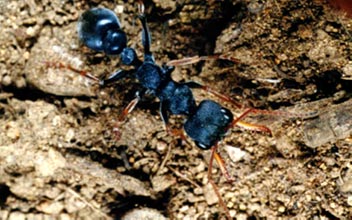Jack Jumper Ant Allergy
Frequently Asked Questions
This document has been developed by ASCIA, the peak professional body of clinical immunology/allergy specialists in Australia and New Zealand. ASCIA information is based on published literature and expert review, is not influenced by commercial organisations and is not intended to replace medical advice.
For patient or carer support contact Allergy & Anaphylaxis Australia or Allergy New Zealand.
![]() ASCIA PC Jack Jumper Ant Allergy 202488.11 KB
ASCIA PC Jack Jumper Ant Allergy 202488.11 KB
Q 1: What is a Jack Jumper Ant?
 Stinging ants can cause severe allergic reactions (anaphylaxis). Allergic reactions to Jack Jumper Ants (also known as Jumper, Hopper or Skipper Ants) are a uniquely Australian problem.
Stinging ants can cause severe allergic reactions (anaphylaxis). Allergic reactions to Jack Jumper Ants (also known as Jumper, Hopper or Skipper Ants) are a uniquely Australian problem.
Most Australian native stinging ants are from the genus Myrmecia. This group is broadly subdivided into Jack Jumper Ants and bull dog ants. Bull dog ants are large, around 15-25 mm long. Jack Jumper Ants are generally 10 to 15mm long with a black body and orange/brown jaws/pincers and limbs.
Jack Jumper Ants do not bite. They grasp the victim in their jaws, then bend and sting them. Their sting is in the tail. They are aggressive and often display jerky, jumping movements. The stings of Jack Jumper Ants can be very painful and local swellings are common. Large local swellings can also occur, which may last a few days at a time.
Other species such as the green ant of Queensland, and the introduced South American fire ant can also cause allergic reactions.
Q 2: Where are Jack Jumper Ants found?
Jack Jumper Ants are found in Tasmania, Victoria, Australian Capital Territory, New South Wales (Snowy Mountains, Blue Mountains and coastal regions), South Australia (Adelaide Hills), and in some parts of Western Australia and Queensland. It is likely that there are other habitats which are yet to be identified.
Underground nests can form massive mounds and are often difficult to find. They may be under rocks, with the entrance surrounded by a pile of fine gravel. A couple of sentry ants may be present at the entrance of the nest.
The ants can be aggressive and often hunt alone. They may stray away from the nest and find their way into people's houses and kitchens. It can be hard to avoid being stung by Jack Jumper Ants when nests are located close to where people live or work.
Q 3: How common is anaphylaxis to Jack Jumper Ant stings?
In areas where Jack Jumper Ants live, population surveys have shown that 2-3% of people have had generalised allergic reactions to Jack Jumper Ant stings. Deaths from Jack Jumper Ant stings and anaphylaxis have occurred in Australia, with several recorded cases in recent years. It is possible that deaths due to sting allergy are under reported.
Follow up studies have shown that around 70% of people with Jack Jumper Ant allergy will have another allergic reaction if they are stung again. This sensitivity to repeat stings persists for many years.
Q 4: What are the symptoms of anaphylaxis to Jack Jumper Ant stings?
Anaphylaxis is the most severe type of allergic reaction and should always be treated as a medical emergency. Anaphylaxis requires immediate treatment with adrenaline (epinephrine), which is injected into the outer mid-thigh muscle. Delayed treatment can result in fatal anaphylaxis.
Signs of anaphylaxis to insect stings or bites can include any one of the following:
- Difficulty or noisy breathing
- Swelling of tongue
- Swelling or tightness in throat
- Wheeze or persistent cough
- Difficulty talking or hoarse voice
- Persistent dizziness or collapse
- Pale and floppy (young children)
- Abdominal pain, vomiting (insect allergy)
Mild or moderate allergic reactions may not always occur before anaphylaxis.
Q 5: How is Jack Jumper Ant allergy diagnosed?
There is currently no skin allergy test commercially available outside of ant allergy research programs.
A blood allergy test is available from SA Pathology in South Australia. Tests can be arranged with your doctor and local pathology laboratory. There may be a small out of pocket cost for this test, which detects around three quarters of cases of Jack Jumper Ant allergy.
Q 6: How is Jack Jumper Ant allergy managed?
Patients with allergic reactions to Jack Jumper Ants should:
- Avoid Jack Jumper Ants.
- Have an ASCIA Action Plan for Anaphylaxis.
- Know when and how to use an adrenaline injector such as Anapen® or EpiPen® if prescribed. Always carry your injectors with you.
- Seek urgent medical assistance if stung.
- Consider Jack Jumper Ant venom immunotherapy. This is currently only available in Royal Adelaide Hospital, Adelaide; Monash Hospital, Melbourne; and in Royal Hobart Hospital, Hobart. This is highly effective therapy and offers protection in up to 90% of patients as demonstrated in a Tasmanian study.
Q 7: How are Jack Jumper Ants avoided?
Jack Jumper Ants are difficult to avoid as they often stray long distances from their nests. Destroying nearby nests has been proposed to reduce the risk of accidental stings but may not prevent stings from nests located further away.
Wearing heavy clothing such as boots and gloves when in the bush or gardening seems sensible but the ants can still sting through heavy clothing.
Q 8: What other measures should people allergic to Jack Jumper Ants follow?
- Do not travel alone in remote areas and consider carrying additional emergency medication if travelling in areas without easy access to medical assistance.
- Carry a mobile or satellite phone/beacon to call for assistance if stung.
- Carry non-drowsy antihistamines when in areas where Jack Jumper Ants are common. Although antihistamines may help relieve very mild symptoms, there is no evidence that they will prevent anaphylaxis.
- Discuss the effects of taking blood pressure or heart medication and anaphylaxis treatment with a clinical immunology/allergy specialist.
Q 9: Is venom immunotherapy available in Australia?
Commercial venom immunotherapy extracts are available in Australia for the diagnosis and treatment of patients allergic to Honeybees, Paper Wasps and European Wasps.
There is currently no commercial venom extract available for skin testing to confirm Jack Jumper Ant allergy, or to use for immunotherapy (desensitisation).
Australian doctors in Tasmania have shown that Jack Jumper Ant venom extracts are effective at switching off Jack Jumper Ant allergy, and preventing allergic reactions when patients were re-stung. This treatment is currently available in Tasmania, Victoria and South Australia.
© ASCIA 2024
Content updated April 2024
For more information go to www.allergy.org.au/patients/insect-allergy-bites-and-stings
To support allergy and immunology research go to www.allergyimmunology.org.au/donate
